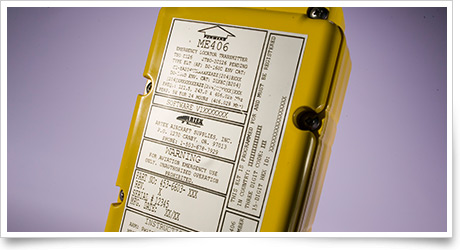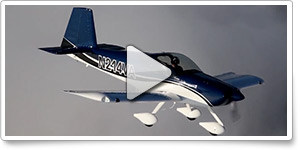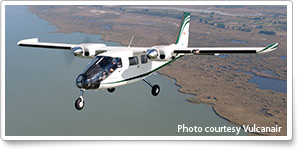Sept. 28, 2012, issue of 'AOPA ePilot: Flight Training Edition' weekly newsletter
| ||||||
| Keeping up on ELTs |
| |||||
Training TipsKeeping up on ELTs
When must the battery in an emergency locator transmitter (ELT) be replaced (or recharged if the battery is rechargeable)?
A) After one-half the battery’s useful life.
B) During each annual and 100-hour inspection.
C) Every 24 calendar months.
From recency of experience or medical certification to aircraft maintenance, pilots have many expiration dates to keep track of to remain in compliance with regulations. That list includes the frequently out-of-sight, out-of-mind ELT—a device that could provide rescuers with vital position information on an aircraft forced down off the airport.
Battery replacement is only one of numerous subjects a student pilot should be able to discuss about the ELT. For example, where is the ELT installed in your trainer? (The tailcone is a common site.)
On what frequency does your ELT transmit upon activation? There was a time when the simple answer to that question was the distress frequency 121.5 megahertz (MHz). Newer units transmit on 406 MHz. Those units are capable of narrowing the search area for a rescue.
There is no requirement to replace an older ELT. “In 2010, the Federal Communications Commission (FCC) proposed banning ELTs transmitting on 121.5 MHz. The proposal encountered strong opposition from AOPA, the aviation industry, and the FAA, which later that year formally requested that the FCC drop the mandate,” says this AOPA article.
Pilots should know, however, that there also no longer is satellite monitoring of ELTs transmitting on 121.5 MHz, leaving overflying aircraft and nearby air traffic facilities as the only receivers of an activated unit’s signal, and possibly making them less effective in a remote area.
On occasion, an ELT can be activated inadvertently by turbulence or a hard landing. Review the discussion in Chapter 6 of the Aeronautical Information Manual for how to check for false alarms.
As for that knowledge test question: This ELT discussion page from AOPA’s Pilot Information Canter explains that batteries “must be replaced or recharged when the transmitter has been in use for more than 1 cumulative hour; or when 50 percent of their useful life (or for rechargeable batteries, 50 percent of their useful life or charge) has expired, as established by the transmitter manufacturer under its approval.” Flight Training NewsNew teen membership tops 950AOPA’s AV8RS program, which offers free youth membership to teens, recently topped 950 members. The program includes an official AOPA AV8RS member card; opportunities to connect with other AOPA AV8RS through dedicated online communities; and a free digital subscription to Flight Training magazine, among other benefits. Read more >> Come chat about airplane ownershipThinking about buying your first airplane? Wondering about how to take that first step into ownership? Bring all your questions to the October Flight Training Facebook chat on Oct. 2 at 3 p.m. Eastern. AOPA Pilot Editor in Chief Tom Haines will discuss making the leap to ownership as well as other ways to get into aviation, such as flying clubs and partnerships. One participant will receive AOPA’s limited-edition “Plane Crazy” T-shirt. To participate in the chat, go to the Flight Training Facebook page and click on the chat link. You can also sign up for an email reminder of the upcoming chat, or view transcripts of previous chats. Checking out on MedXPress as the paper form checks outOn Oct. 1, the paper version of the FAA airman medical application will be retired and all medical applications will be completed online. The FAA’s MedXPress went live in 2007 to complement the hard-copy FAA Form 8500-8. However, the plan all along was to comply with federal guidelines to move to electronic documentation and phase out the paper form. Read more >> Hand-prop surprise?When North Carolina pilot Bruce Stanfield went to hand-prop his Cessna Cardinal in the summer of 2005, he was stunned by what occurred next. Hear, in his words, what happened—and learn what simple actions might have prevented it. Watch the Air Safety Institute’s Real Pilot Stories: Propping Accident . North Carolina flight school relocatesDillon’s Aviation has moved its satellite flight school from Fayetteville to Raleigh Exec Jetport at Sanford-Lee County in Sanford, N.C. The headquarters and maintenance shop remain at Pitt-Greenville Airport in Greenville, N.C. The move gives the flight school more space, including classrooms, an office area, a conference room, and more hangar space, according to FayObserver.com. An open house will be held at Raleigh Exec from 9 a.m. to 5 p.m. on Oct. 6. New Jersey community college opens aviation education centerBergen Community College opened the doors to its new aviation education center on Sept. 21 at its Paramus, N.J., campus. The center features flight simulators and a wind tunnel, and was made possible by a $2 million grant from Emil Buehler Perpetual Trust. The college offers an associate’s degree in aeronautics, with specialties in aircraft operations and aviation administration. Students who earn an associate’s degree in aeronautics can transfer to Vaughn College in Flushing, N.Y., to obtain a bachelor’s degree in aeronautics, avionics, and airport management. Training ResourcesDid you know? The most misused term in aviation is the word “Roger.” So, what does it convey? The Air Safety Institute’s Say It Right: Mastering Radio Communication online course explains its true meaning, while exploring other misnomers routinely abused by pilots. Learn how to communicate properly and effectively from the cockpit and improve safety when you avoid inappropriate phraseology. The course is sponsored by Lightspeed Aviation.
Did you know that student pilots who join AOPA are three times more likely to complete their flight training? Membership includes unlimited access to aviation information by phone (800/USA-AOPA, weekdays from 8:30 a.m. to 6 p.m. Eastern time) or from Flight Training Online or AOPA Online. If you’re not already a member, join today and get the pilot’s edge. Login information is available online. Van’s RV-14 Career PilotSkyWest announces American Eagle agreementSkyWest Inc. announced Sept. 12 that it has signed a four-year capacity purchase agreement with American Airlines to operate 23 Bombardier CRJ200 regional jets under the American Eagle designation. SkyWest anticipates beginning its American flights on Nov. 15, with all 23 aircraft in service by the end of the first quarter 2013. SkyWest said the aircraft will come from its existing fleet, where they previously were operated for another major partner; the company indicated that 12 of the aircraft will be flown by SkyWest Airlines and 11 by ExpressJet Airlines. They primarily will be operated out of Los Angeles and Dallas/Fort Worth international airports. BBJ sets record on long-range flightBoeing Business Jets set a new world record for speed over a recognized course when a BBJ flew nonstop from Los Angeles to Auckland, New Zealand, for installation of its VIP interior. The Boeing 737-700, modified for VIP use, made the 5,658-nm trip in 13 hours, 7 minutes, and 54 seconds. Capt. Steve Taylor, BBJ president, said the trip demonstrates the incredible range capability of the BBJ. “When we left Los Angeles with full fuel, we were 21,000 pounds below our maximum takeoff weight. This means that the customer can add a full VIP interior, fill all the seats, and still carry full fuel and have remarkable range.” He said the airplane had 7,800 pounds of fuel remaining when it landed in Auckland Sunday evening. The BBJ, owned by Samsung Electronics, is equipped with seven auxiliary fuel tanks, giving it the extended range. Plane SpotterVulcanair: Two wings and a view Training ProductsRedbird Cygnus from King SchoolsConnect your flight simulator to your favorite aviation apps running on your smartphone or tablet via the Redbird Cygnus Home Direct or Cygnus Pro Wireless devices. The location of your simulated aircraft is sent to your device, fooling it into believing it is where your simulated airplane is—which in turn allows you to use any app just as you would on an actual flight. The Cygnus Pro Wireless, priced at $599, lets you wirelessly connect five mobile devices to a sim. The Cygnus Home Direct, priced at $199 and available soon, lets you directly connect one device to a sim. For more information, see the website or contact King Schools at 800/854-1001.
Note: Products listed have not been evaluated by ePilot editors unless otherwise noted. AOPA assumes no responsibility for products or services listed or for claims or actions by manufacturers or vendors. Member BenefitsColor vision tests and FAA requirementsColor vision deficiency is the inability to differentiate between certain colors or, in more severe cases, to be able to see colors at all, also known as “color blindness.” Most individuals with color deficiency can see colors, but have difficulty identifying differences between shades of red and green or, less commonly, blue and yellow, and the deficiency varies from mild to severe. Dr. Warren Silberman discusses the FAA’s testing policies on color deficiency in this report from AOPA Pilot Protection Services. Read more >> BlogsDumb things pilots have done, Part IIIn the second part of a two-part installment, professional pilot Chip Wright reveals evidence that the FAA has eyes in the back of its head. Also in the Flight Training blog, Technical Editor Jill W. Tallman shares more solo stories found in the media. Engine failure on takeoffCFI Jason Schappert examines the must-do items on your mental checklist if the engine fails on takeoff with and without runway remaining in the Let’s Go Flying blog. AOPA Career OpportunitiesEver dream of turning your passion for aviation into a career? We’re looking for a director of media relations, major gifts officer, accounts payable technician, aviation technical generalist, and Web graphic designer. To learn more about other AOPA career opportunities, visit AOPA Online. Community
AVIATION EVENTS & WEATHER
| ||||||||||||||||||||||||||||||||||||




 A sample question from the FAA
A sample question from the FAA 





